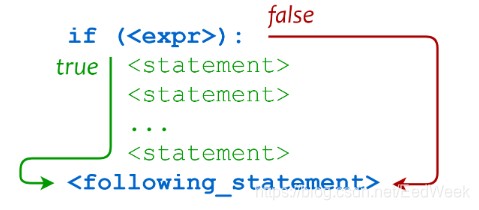Python 条件语句是通过一条或多条语句的执行结果(True 或者 False)来决定执行的代码块。
可以通过下图来简单了解条件语句的执行过程:

代码执行过程:

if 语句
Python中if语句的一般形式如下所示:
if condition_1:
statement_block_1
elif condition_2:
statement_block_2
else:
statement_block_3
如果 "condition_1" 为 True 将执行 "statement_block_1" 块语句
如果 "condition_1" 为False,将判断 "condition_2"
如果"condition_2" 为 True 将执行 "statement_block_2" 块语句
如果 "condition_2" 为False,将执行"statement_block_3"块语句
Python 中用 elif 代替了 else if,所以if语句的关键字为:if – elif – else.
注意:
1、每个条件后面要使用冒号 :,表示接下来是满足条件后要执行的语句块。
2、使用缩进来划分语句块,相同缩进数的语句在一起组成一个语句块。
3、在Python中没有switch – case语句.
#!/usr/bin/python3
age = int(input("请输入你家狗狗的年龄: "))
print("")
if age <= 0:
print("你是在逗我吧!")
elif age == 1:
print("相当于 14 岁的人。")
elif age == 2:
print("相当于 22 岁的人。")
elif age > 2:
human = 22 + (age -2)*5
print("对应人类年龄: ", human)
### 退出提示
input("点击 enter 键退出")
###以下为if中常用的操作运算符:

if 嵌套
在嵌套 if 语句中,可以把 if...elif...else 结构放在另外一个 if...elif...else 结构中。
if 表达式1:
语句
if 表达式2:
语句
elif 表达式3:
语句
else:
语句
elif 表达式4:
语句
else:
语句
#eg.例子
# !/usr/bin/python3
num=int(input("输入一个数字:"))
if num%2==0:
if num%3==0:
print ("你输入的数字可以整除 2 和 3")
else:
print ("你输入的数字可以整除 2,但不能整除 3")
else:
if num%3==0:
print ("你输入的数字可以整除 3,但不能整除 2")
else:
print ("你输入的数字不能整除 2 和 3")
#!/usr/bin/python
# -*- coding: utf-8 -*-
#Author: zhaosj
# ###判断语句###
# if condition:
# do
# else:
# do
# #注意:冒号和缩进
# if condition:
# do
# elif condition:
# do
# else:
# do
++++++++++++++++++++++++++++++++++++++++++++
#eg.:密码登录判断
#定义确认登录函数
def count_login():
password = input('password:')
if password == 123456:
print ('输入成功!')
else:
print ('输入错误!请再次输入')
count_login()
#函数调用
count_login()
#执行结果:
[root@bigdata script_ce]# python zhaosj_if.py
password:123
输入错误!请再次输入
password:12345
输入错误!请再次输入
password:123456
输入成功!


